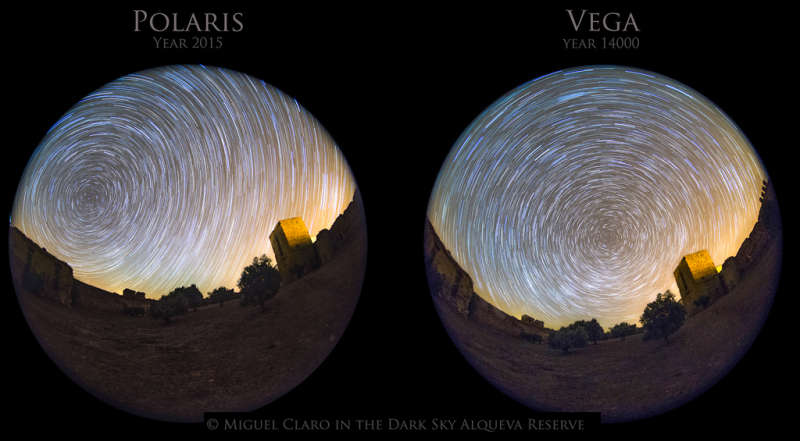Credit & Copyright: Miguel Claro |
Dark Sky Alqueva
Explanation:
In only about 12,000 years
Vega
will be the North Star, the closest
bright star to our fair planet's
North Celestial Pole.
By then, when you fix your camera to a tripod
long exposures of the night sky
will show the concentric arcs of star trails centered
on a point near Vega as Earth rotates
on its axis.
Of course, presently the bright star conveniently near the
North Celestial Pole is Polaris,
but that will change as the Earth's
axis of
rotation precesses,
like the wobble of a spinning top with a precession period of
about 26,000 years.
If your camera is ready now and you don't want to wait 12,000 years
for Vega to be the North Star,
consider this ingenious demonstration
of contemporary star trails (left) versus
star trails reminiscent
of the year 14000 CE.
Both were recorded this April at the
Alqueva Dark Sky Reserve in Alentejo, Portugal.
To produce the more Vega-centric star trails of the
distant future, astronomer Miguel Claro
combined the rotation of two startracking camera mounts to
create the apparent shift in planet Earth's North Celestial Pole.
1999 2000 2001 2002 2003 2004 2005 2006 2007 2008 2009 2010 2011 2012 2013 2014 2015 2016 2017 2018 2019 2020 2021 2022 2023 2024 2025 |
Yanvar' Fevral' Mart Aprel' Mai Iyun' Iyul' Avgust Sentyabr' Oktyabr' Noyabr' Dekabr' |
NASA Web Site Statements, Warnings, and Disclaimers
NASA Official: Jay Norris. Specific rights apply.
A service of: LHEA at NASA / GSFC
& Michigan Tech. U.
|
Publikacii s klyuchevymi slovami:
Vega - north pole - north star - Vega - Precessiya - severnyi polyus
Publikacii so slovami: Vega - north pole - north star - Vega - Precessiya - severnyi polyus | |
Sm. takzhe:
Vse publikacii na tu zhe temu >> | |
